By Jessie Scott
As his website puts it: “Ian Haig works at the intersection of visual arts and media arts. His work explores the strangeness of everyday reality and focuses on the themes of the human body, devolution, abjection, transformation and psychopathology, often seen through the lens of low cultural forms.” Which comes close, but doesn’t really do justice to Haig’s sprawling, irrepressible, earnestly deranged, and defiantly grotesque, bod(ies) of work.
His epic, long-form, straight-to-DVD mash up of video emissaries from the outer fringes of Sci-Fi/new age/consumer culture, Chronicles of the New Human Organism (50min, 2005-2010) was recently included in Not Fair, a fringe event to the 2012 Melbourne Art Fair, held in Thousand Pound Bend’s gallery space.
Reminded of the awesomeness of this video, which has screen previously at CCP and at ACMI, Jessie Scott interviewed him via email to find out more about how it came to be and why, getting him fired up about the state of Video Art in the process…
______
Picture Skew: Describe, in your own words, the work Chronicles of the New Human Organism: what it is about and how it came about…
Ian Haig: Chronicles came about as a desire to try and make a feature length video project…which seemed like a good idea at the time. It’s not quite a feature, but it came close. I have made many shorter video works over the years and was really trying to make something more substantial. The work took around 4-5 years to make and is a amalgam of all sorts of things, from CSIRO science documentaries, mondo movies, Erich Von Danikens’s Chariot of the Gods and educational videos to Carl Sagan. I was also looking at various new age videos online and how the narrative of a lot of new age culture verges on a form of science fiction, the transformation of the human body and the ascension of the body, to new states of consciousness, these kinds of things, all of which the work drew, so it’s a real melting pot of references.
PS: Chronicles conflates science with religion, sex with technology, and nature with commerce through its appropriation (or aesthetic referencing) and juxtaposition of everything from nature documentaries, new age religion, science fiction, exploitation film, pornography, infomercials to horror. I’m assuming there is some found footage involved – but then the quality of footage seems so consistent throughout. How much of the footage was generated by you, and how much was ripped, and from what sort of sources?
IH: The production for the work coincided with some artist residencies I was doing at the time in Seoul and in Los Angeles, so I used the residencies as a way of shooting and developing the work, in places like Japan, Thailand, remote parts of Korea and California and Las Vegas. Around 80 percent of the video I shot and the other 20 percent is archival footage and some footage I purchased, which is one of my favorite shots of a girl eating a scorpion in Thailand. The video really is this kind of weird cannibalistic travelogue from many locations over a number of years. I didn’t want to make purely a found footage video but a more hybrid, mixed up work, more in line with how a real cult recruitment video world appear. I wanted to keep that ambiguity in the work, was this for real? Is this a video art work? What is this?
For me also what really brought the work together was the sound design and music by PH2 (Philip Brophy & Philip Samartzis). The sound and music really brings an otherworldly weirdness to the whole project.
PS: Second part of that question is, in working on such a long-form piece – did you have a clear idea of where it was headed as you made it, or did you work in a more free-form, intuitive way? Is research and planning a big part of your work?
I had been collecting lots of fanatical text stuff from various web sites over the years, from cult web sites, fringe science, alternative health, these kinds of things, and I thought the best way of doing something with it would be to use it and re-configure it as material for a voiceover for a pseudo science documentary… So this was the beginning of the video.
As I had so much text, I knew the video work was going to be long, I also like the duration of the work, as it’s like a real cult recruitment video that just wears you down with its unrelenting language. Early on I knew the narration would be important for keeping an audience’s attention over a 50 min period. The work was always made with a theatrical screening in mind opposed to a gallery outcome. In some respects I am critical of video art in galleries that one engages with for 20 seconds. I wanted to force the audience to sit through the work and not give them a choice, the last thing you want to give an audience is a choice.
I want to impose my aesthetic sensibility onto them, not to make it easy for them to walk away from the work, you can do this more in a theatrical setting. I feel there exists this kind of slacker induced idea of engaging with video art, you don’t really watch anything anymore in galleries you just browse the work momentarily.
The work was somewhat planned, in the sense that if I broke it down into sections it would be easier to produce and edit. But there was no real script, just notes and notes of text for the voice over. I had some particular locations in mind, that I wanted, the Luxor casino in Las Vegas and lots of bubbling mud and tar pits for example…that was really my starting point and it evolved slowly as I collected the footage.
PS: Although you have been incredibly prolific in a range of mediums, you are well known for being a pioneer of new media art. Do you see yourself as tied to a medium, or particular area of media arts practice? And how does this epic piece of straight video art fit into all that?
IH: I don’t particularly have any allegiance to new media art, anymore than I have an allegiance to video art or installation or drawing or whatever…I don’t really understand that idea of artists who are devoted to just one medium, my work has always been very hybridised, it’s never been just one thing. Its all just material to use, depending on what services the idea…it may be video, or sculpture or drawings of robotics…in some ways it’s not my role to be an ambassador for a given medium or idiom, I just make the work.
There is almost an unconscious need to categorise artists, you either draw, paint, make video, or produce new media, sculpture, you can combine some of those things but not all of them. If you work eclectically across media like I do, you’re possibly perceived as being kind of ad hoc, of not working consistently in your chosen idiom. I like the fact my work is so bastardised, it seems entirely apt to work in this way, as culture itself is so diverse and mutant.
In the early and mid nineties I was probably initially associated with new media art, as this is where the opportunities were to show my work. Twenty years ago galleries seemed somewhat allergic to video art and any kind of technology driven work, but this is now changing. In some respects my practice comes out of a media arts culture, and an obsession with film and movies, possibly more so than coming out of purely a visual art sensibility.
I see Chronicles of the New Human Organism as a weird narrative work, and ideas of narrative have often appeared in my work over the years in different forms…I can’t escape narrative, its everywhere. Many of my sculptural works, installations and web based works have a narrative or sorts which the work hangs off, or some kind of back story to the ideas…
PS: Back in November 2010 you curated Philip Brophy’s critical survey of advertising tropes, “ADS” into the Video Void screenings at CCP. At the time you cited it as a defining influence on you, and lamented the fact that there was no “ADS” of this generation (paraphrasing). Are you able to elaborate on that sentiment a bit more – what is it about that work that you think is lacking in contemporary video practice?/why?
IH: I think for me, ADS was really coming out of that whole Paul Taylor Pop-ism period in the early ’80’s in Melbourne which did have an impact on me for sure. This notion of art that reuses the material of its culture has been something my work has done over the years. Sometimes perhaps not in a direct way, but even some of my sculptural works have been based on the pre-existing, found materials, and referencing different aspects of culture…opposed to this idea that art is constructed in a void, as if it’s somehow separate from the culture around it.
Video art is now validated by the gallery and institution, which wasn’t always the case, in the process there kind of now exists a type of video art, that galleries and museums love, it’s in slow motion, and non narrative and probably made by painters. Part of video art’s ‘success’ in the art world is also part of its failure in a weird way. Its acceptability as a medium has emerged out of largely a painting practice and not a screen based media art practice which has resulted in some terribly banal video art.
PS: And, do you think Chronicles, which collects, catalogues and collages popular video imagery, in a manner similar to ADS is in some way addressing that lack?
IH: Possibly, I am not sure… I realised about half way through making the work, that it was a hard one to categorise, was it a documentary? Was it a genre, science fiction piece? A narrative? Was it video art?…I like this notion of the unclassifiable. The idea that it’s all of the above, but at the same time, it’s something entirely different…I guess in some ways the video is a collection from the data banks of culture, this kind of weird catalogue of scenes, associations, relationships of images…
PS: You have described your own work as being about “the science fiction of sexuality, the degenerative and malign aspects of pervasive new technologies, to cultural forms of fanaticism and cults, to ideas of attraction and repulsion”. These themes have been explored and exercised (and exorcised!) extensively in your work across many different mediums over the years. Where did this fascination for the grotesque, the abject (hate that word), the visceral, the absurd, and how it all intersects with sexuality, technology and popular culture begin?
IH: Firstly I have always thought art is meant to be weird, it’s meant to be strange and offer a portal into other parts of culture and our lives we don’t normally engage with…that’s its job. Mike Kelley said that art’s social function is to be negative…I’ve come to really agree with this.
There are so many artist in the world now, too many in fact, in some respects we don’t need any more artists. I find lots of art kind of forgettable, I like art that stays with you, like a horror movie, that you can’t get out of your head…
I am interested in ideas of the body, as in many ways it’s all about the body, it’s the basis of everything, it’s what we inhabit, so for me, it’s the area I go to almost automatically as an artist. Much of my work goes back to that Cronenberg-ian idea of the schizophrenic nature we have of the body, the idea that we are OK with the body and its exterior but repulsed by the interior of the same body…
My work has seen an ongoing series of obsessions, one of which is the very idea of aesthetic value. In some respects we already know what beauty is, we don’t need art to re-instate the obvious and supply us with another beautiful image or composition, art should take us somewhere else, provide us with a different kind of emotion. John Waters calls it ‘reverse beauty’ which also leads to the grotesque, the ugly, the visceral, all of which are not easily validated like the notion of beauty is, you have to work at it, why you are attracted to something that is absurdly repellent? I feel is a far more complex and compelling idea of aesthetics then a desire for beauty in the world.
The world of pop culture, you tube, movies is often more weird than anything in contemporary art. My art practice acknowledges this, so anything I do needs to be at least as strange and weird as the culture, movies, etc that I am immersed in. I think perversity is interesting, it’s the taking of something, an idea, a material to an extreme, that it transforms it into something else, this is something that seems central to my work as well and is very much part of the video.
PS: There is a lot of humour, occasionally juvenilia and a large dose of coprophilia evident in your work, which has close ties to popular culture and media. Do you have a quote-unquote serious critical or theoretical agenda for your body of work, and for Chronicles in particular? Do you embrace or eschew such evaluations of art?
IH: Sometimes working with such themes, I guess the work is dismissed as Juvenilia. It’s weird, art is allowed to be humorous in a certain way, but if it goes too far in one direction its dismissed as puerile and incapable of having value. However in some respects I don’t have an issue with Juvenilia, its other people’s problem not mine.
The whole high art/low art discussion has gone around in circles for the last forty years and in some respects the art world has become incredibly hierarchical I would say almost medieval in its construction of culture. Its OK to talk in terms of ‘popular culture’ and the high art low art schism in the context of the gallery, under halogen lights and temperature controlled rooms. But the minute you reference those aspects of low culture that are potentially very lowly and base level, its seen as unpalatable and crude. I’ve never really understood that, you can’t have it both ways, if you are going to pay lip service to high and low culture you have to accept it on its own terms and not only aspects of low culture that signify ‘popular culture’ in an obvious kind of way, like images of hot rods or something.
I don’t buy into the notion of art that has this perceived value, a belief that art has some kind of intrinsic currency in the world. So in a sense my work around toilets or more recently (fake) corpses, is working with material that has no perceived value at all and in so doing activating ideas around them and giving them a weird and twisted kind of cultural value. I find that interesting…it’s this notion of denying any kind of obvious value in the work, so you need to work at it as a viewer to arrive at its value, rather then paying lip service to the idea that art’s imperative is to present value to you in easily digestible chunks of meaning.
My work isn’t anti intellectual at all, its seriously engaged in ideas that sometimes just happen to be perversely humorous. I don’t have any particular agenda in my work I am trying to push, I have no message for anyone…its more a collection of obsessions and ideas that circulate around like a cloud, which often intersect with ideas of the body and technology amongst other things.
PS: Despite your association with new media’s early utopian era, works of yours like Chronicles seem to have a pretty irreverent and even cynical attitude to new technology and science, leaning on them them extensively as organising principals, but sending them up mercilessly at the same time. In your opinion, what are the “degenerative and malign aspects of pervasive new technologies”?
IH: New media artists are terribly uncritical of their own culture….however by the same token I find it odd that artists and galleries sometimes still have issues with technology in art practice…this is the vernacular of our times, it’s just technology, get over it.
However the problem has always been the unabashed utopianism of new media art, together with its conceptual framework of progress, advancement, and the sophistication of technology all of which I find problematic. I’ve always been interested in fucking with technology, doing something ugly with it, something mutant, that is violently opposed to utopianism. I guess I view this is the degenerative and malign aspects of technology, to use it for bad things, ugly, horrible purposes, instead of this notion of positivity and the future and enhancing the world…I like to take things the other way.
I’m also hyper allergic to art that has a purpose, a function, a use-value, of art that tells the viewer something about the environment for example, or art that attempts to solve a problem, such concerns are of no interest to me…While I don’t really have an affinity with the new media art fraternity, by the same token I often use technology in my work, so I guess by default I am a new media artist, but I am hyper critical of it at the same time. In some respects I probably more accurately sit in the space somewhere between new media art and visual art…some grey, unknown zone.
I should point out my references in my new media art work, have consistently been people like J.G Ballard and even more so David Cronenberg, cultural reference points which almost seem ignored within the new media art world. Both Ballard and Cronenberg have explored the pathology of the body and its relationship to the machine/technology for some time in ways that are probably much more radical then new media art.
I am very cynical of new media art that collaborates with science, almost as a pathetic form of cultural validation…I am much more interested in pseudo science, fringe science or science fiction, all of which has informed the video work. Culturally there is this perception of the authority of science, as a system of knowledge and ideas, I wanted to use that in the video, but use it for the wrong purposes, for the wrong reason, kind of like a science doco, explaining the nature of the world around us, that has gone off the rails.
PS: In recent years you have exhibited drawings alongside your installation work. (Note: There is a series of drawing made over the last 5 or 6 years shown with Chronicles at Not Fair). Given the techno-fetishism of new media art in the ’90s and early 2000s, and your own particular association with that scene, can you talk about how drawing fits with the rest of your practice? Do you see it as an adjunct to particular projects, a starting point for developing other works, or have you pursued it as an end in itself?
IH: All of the above. I don’t really place it anywhere in a way. I started to include drawings sometimes in my work around 10 years ago. Lots of my work including the video, is around ideas of fanaticism and drawing seems like a logical voice for that that, more so than other media in many ways. It’s kind of the creative tool of the mental patient and the institutionalised. Recently I did some drawing which copied the drawings of a six-year-old autistic boy, so there is this connection to drawing and different ways of thinking about the world around us, drawing as a connection to a pathology…these kinds of things…
I am not sure how the drawing fits in with the rest of my practice, that’s up to someone else to figure out…it fits in because I did them.
PS: You could say that in the fall out of that techno-fetishism, drawing, painting and hand-made art in general has had a bit of a renaissance in the last 10 years – graphic design has returned to its applied arts roots and contemporary art has re-embraced evidence of “the hand of the artist”. Given this, do you feel like curators and gallerists, as well as audiences are more receptive now to your drawings than they have been previously? Or have you always made and shown drawing as part of your exhibition practice, and I’ve only just noticed it now?
IH: I am less inclined to think of drawing in romantic terms of the hand made, drawing has always been a fast and direct route to the imagination, of getting an idea out of your brain and into the world, which is what I like about it. I haven’t found curators or gallerists to be more receptive to my drawings at all.
PS: Finally, will there be more videos like Chronicles in your future? What are you working on now?
IH: I thought about the idea of doing a part 2, longer and even more ambitious, but considering this one took around 5 years, this probably wont happen. However I like the idea of someone coming across an old dusty DVD copy of Chronicles of the New Human Organism in their library at school and watching it in say 20 years…and perhaps using it as the basis for a science project.
At the moment I am working on some projects using Arduino, and electronics to create weird kinds of prosthetic special effects, that exist in the real world and not the world of a movie…re-animating body parts and corpses stuff like that.
________
Chronicles of the New Human Organism will be screened at Tape Projects in November – more info closer to the date.
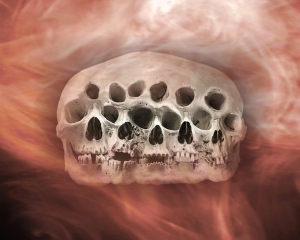
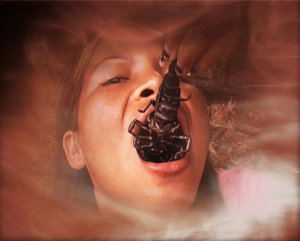
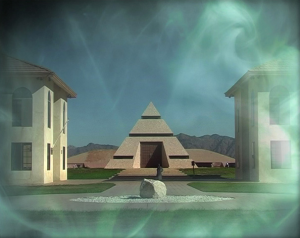
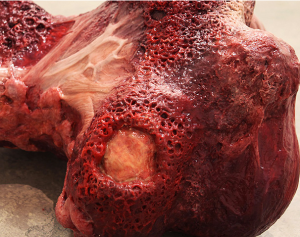
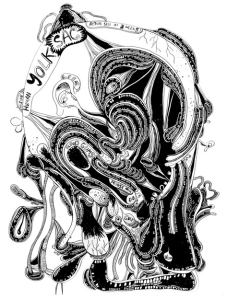
Pingback: A recent interview — ianhaig.net